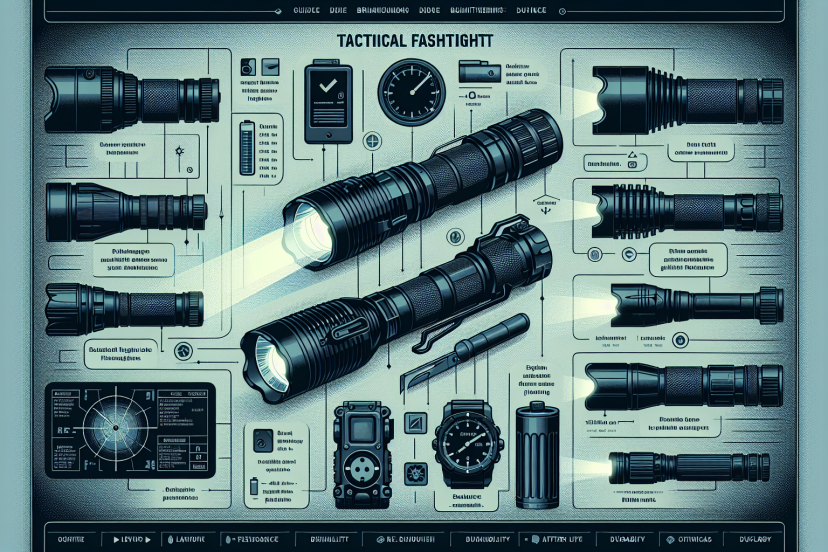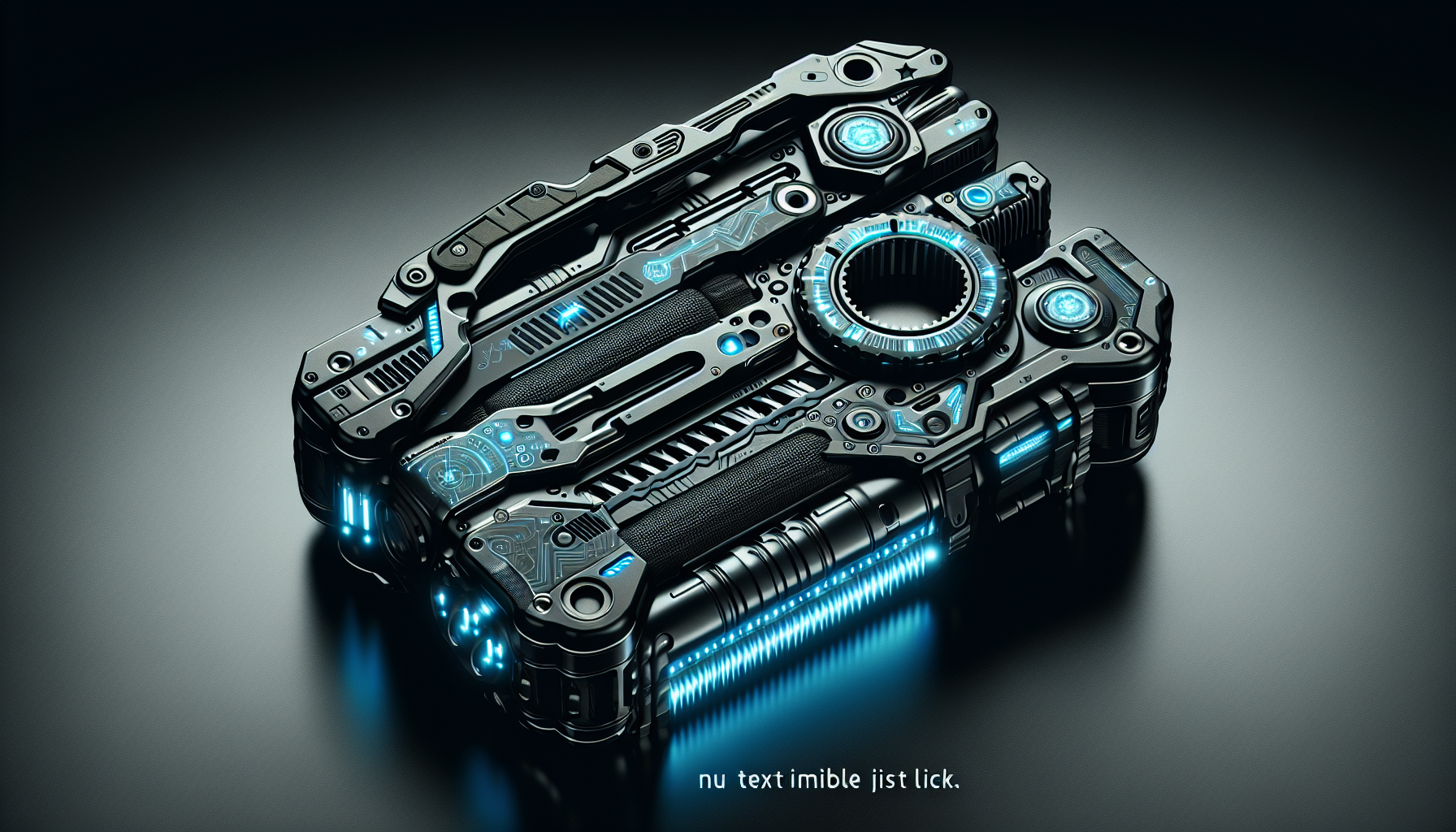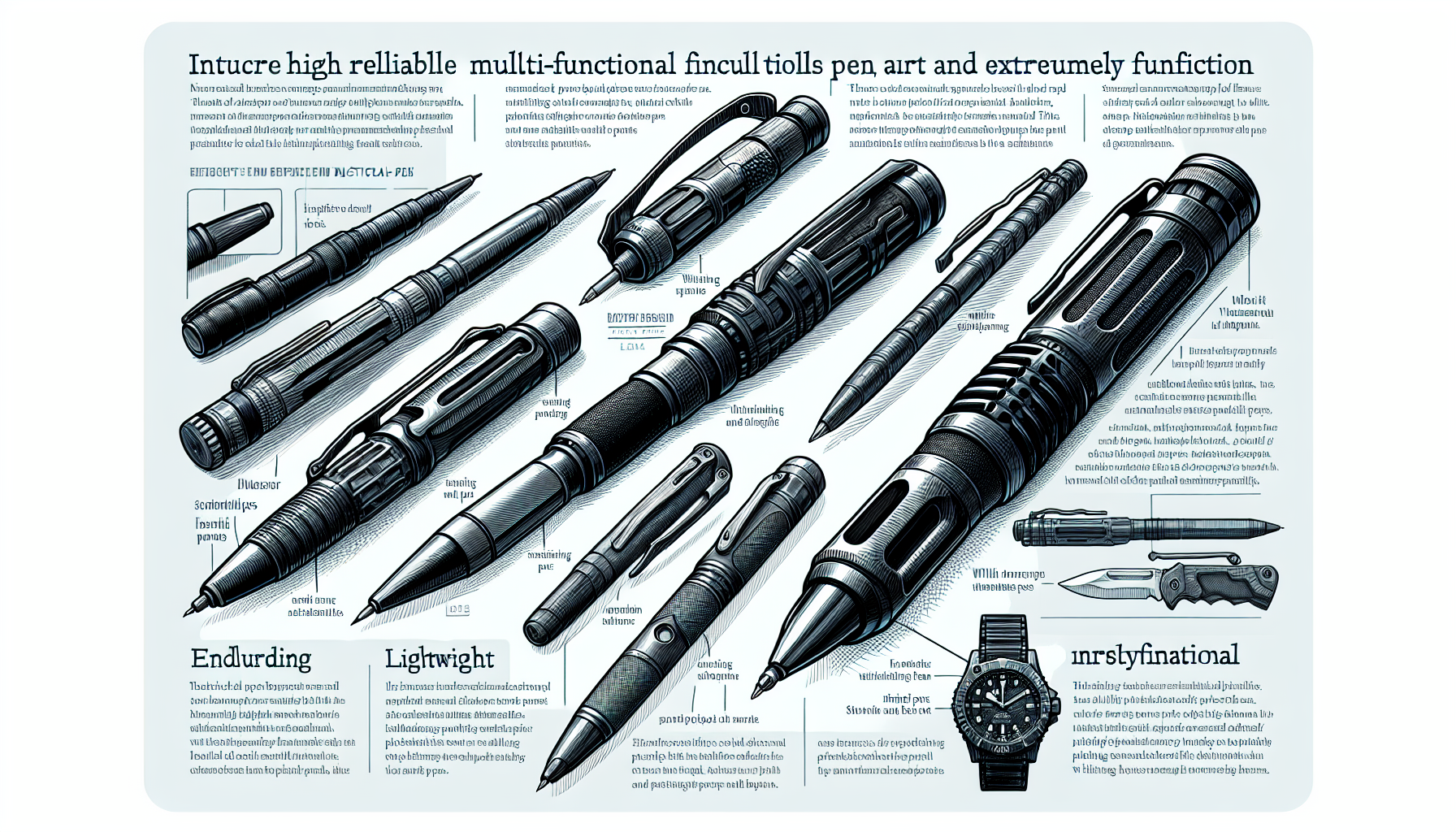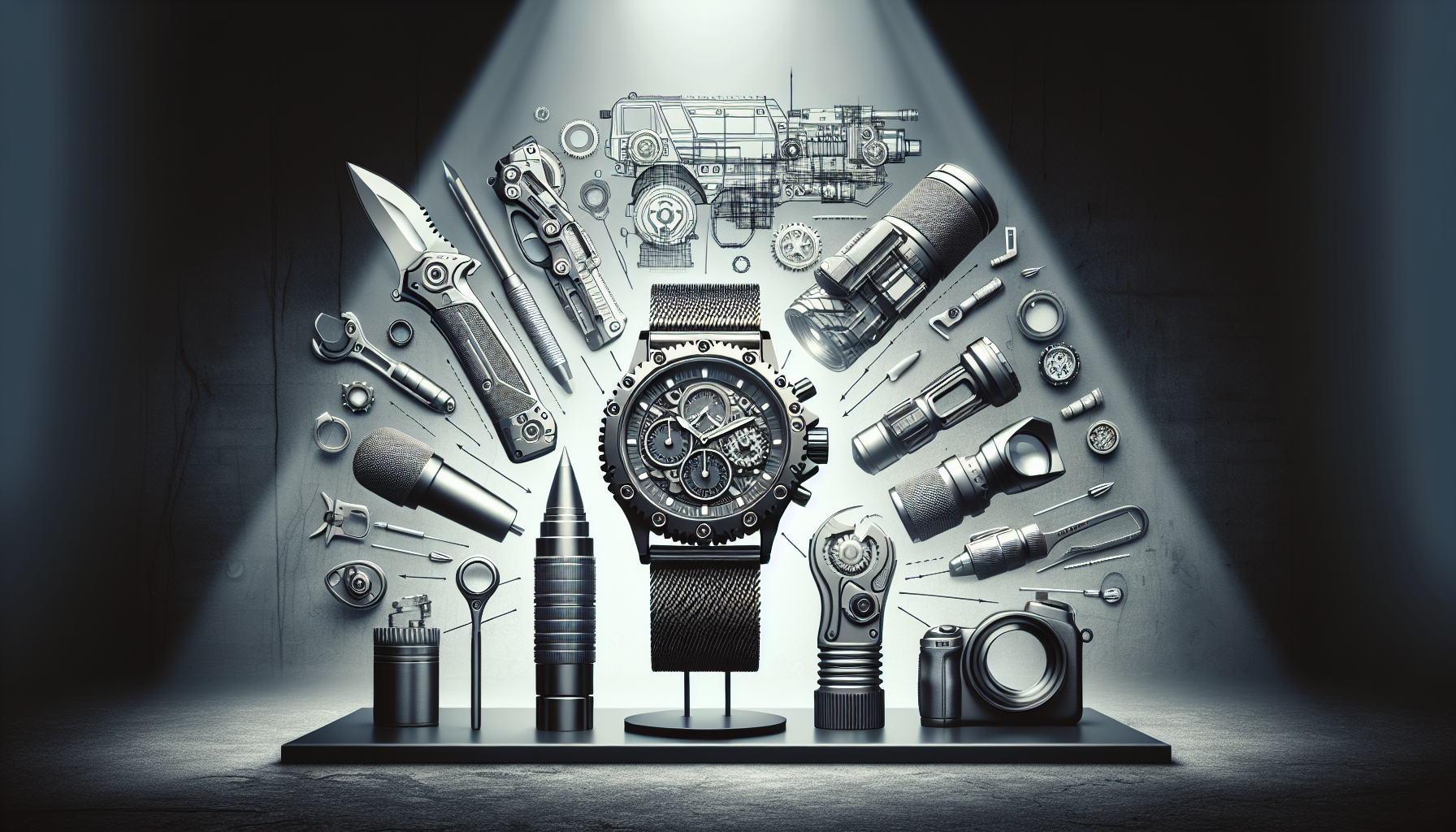The Ultimate Guide To Tactical Flashlights: How To Choose The Best One For Your Needs
In this ultimate guide to tactical flashlights, you will discover everything you need to know in order to choose the best one for your specific needs. Whether you’re an outdoor enthusiast, a first responder, or simply looking for a reliable source of light during emergencies, this article will provide you with valuable insights and tips. From lumens and beam distance to battery life and durability, we’ll explore the key features and factors to consider when selecting a tactical flashlight. Prepare to shine a light on your adventures with confidence and convenience.
The Ultimate Guide To Tactical Flashlights
Benefits of Using Tactical Flashlights – Increased visibility in low-light situations
One of the primary benefits of using tactical flashlights is the increased visibility they provide in low-light situations. Whether you’re camping in the woods, walking your dog at night, or experiencing a power outage, a tactical flashlight can be a lifesaver. These flashlights are designed to emit a powerful beam of light that cuts through the darkness, allowing you to see clearly and navigate your surroundings with ease. With a tactical flashlight in your hand, you no longer have to rely on dim street lights or the weak glow of your smartphone to light the way.
Durable and long-lasting
When it comes to tactical flashlights, durability is key. These flashlights are built to withstand tough conditions and are often made from high-quality materials such as aluminum or stainless steel. This makes them incredibly durable and long-lasting, ensuring that they can withstand the wear and tear of everyday use. Whether you drop it, expose it to extreme temperatures, or use it in rugged outdoor environments, a tactical flashlight will remain functional and reliable.
Versatility in various environments
Another advantage of tactical flashlights is their versatility in various environments. Whether you’re hiking in the mountains, camping in the wilderness, or working on a construction site, a tactical flashlight is a versatile tool that can adapt to any situation. Many tactical flashlights offer different brightness levels and adjustable focus, allowing you to customize the beam of light to suit your needs. This versatility makes it easy to use a tactical flashlight for a wide range of tasks, from illuminating a large area to focusing on a specific object or area.
Self-defense tool
In addition to their primary function of providing light, tactical flashlights can also serve as a self-defense tool. These flashlights are often engineered with features that make them suitable for self-defense, such as a sturdy construction, a bezel around the lens that can be used for striking, or a strobe mode that can disorient an attacker. Having a tactical flashlight on hand can provide you with an added sense of security and the ability to defend yourself in unexpected situations.
Factors to Consider Before Buying a Tactical Flashlight
Brightness and light output
When choosing a tactical flashlight, brightness and light output should be at the top of your list. The brightness of a flashlight is measured in lumens, which determines how far the light can reach and how well it illuminates the surrounding area. Higher lumens generally indicate a brighter flashlight, but it’s important to consider your specific needs. If you primarily use the flashlight indoors or in close quarters, a lower lumen output may be sufficient. However, if you need a flashlight for outdoor activities or long-distance visibility, a higher lumen output will be more necessary.
Battery life and power source
The battery life and power source of a tactical flashlight are crucial factors to consider before making a purchase. Flashlights can be powered by various sources, including standard alkaline batteries, rechargeable lithium-ion batteries, or even solar power. It’s important to choose a flashlight with a power source that is convenient and practical for your needs. Additionally, consider the expected battery life of the flashlight, especially if you plan to use it for extended periods without access to charging options.
Size and weight
The size and weight of a tactical flashlight can significantly impact its usability and portability. You’ll want to choose a flashlight that fits comfortably in your hand and is easy to carry around. A compact and lightweight flashlight can be more convenient for everyday use, while a larger and heavier flashlight may be necessary for specific tasks or environments that require a more robust lighting solution. Consider the intended use of the flashlight and your personal preferences when evaluating the size and weight of potential options.
Durability and construction
Since tactical flashlights are designed for rugged use, their durability and construction are essential factors to consider. Look for flashlights constructed from durable materials such as aluminum or stainless steel, as they can withstand impacts, drops, and harsh environmental conditions. Additionally, check if the flashlight has been tested and certified for durability or meets specific standards, such as military-grade or ANSI FL1 standards. A well-built flashlight will provide you with confidence in its longevity and ability to withstand demanding situations.
Water resistance and weatherproofing
Considering the weatherproofing and water resistance capabilities of a tactical flashlight is crucial, especially if you plan to use it outdoors or in wet environments. Look for flashlights with an IPX rating, which indicates the level of water resistance. Higher IPX ratings, such as IPX7 or IPX8, signify a higher degree of water resistance. This allows the flashlight to withstand rain, splashes, and even being submerged in water for a certain period. By choosing a water-resistant flashlight, you can ensure its functionality and avoid damage caused by moisture or liquids.
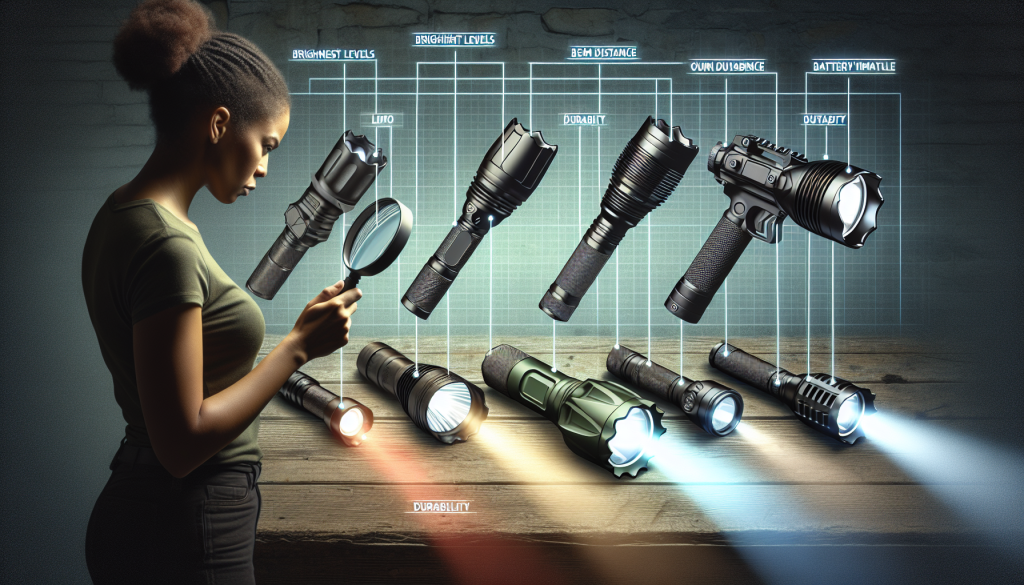
Different Types of Tactical Flashlights
Rechargeable flashlights
Rechargeable flashlights are becoming increasingly popular due to their convenience and cost-effectiveness. These flashlights can be easily recharged using a USB cable, a wall outlet, or even a solar charger. Opting for a rechargeable flashlight reduces the need for constantly purchasing and disposing of batteries, making it an eco-friendly choice. Additionally, rechargeable flashlights often offer adjustable brightness levels, allowing you to customize the light output based on your needs.
Compact keychain flashlights
Compact keychain flashlights are small, lightweight, and portable, making them a convenient option for everyday carry. These flashlights can easily attach to your keychain, ensuring you always have a source of light within reach. Although they may not provide the same level of brightness as larger flashlights, compact keychain flashlights are ideal for quick tasks or emergencies where a small amount of light is sufficient.
Weapon-mounted flashlights
Weapon-mounted flashlights are specifically designed to attach to firearms, providing both illumination and aiming assistance. These flashlights enhance the visibility of potential threats in low-light situations while keeping your hands free to operate the weapon. Weapon-mounted flashlights often feature pressure switches that allow for easy activation without compromising your grip on the firearm. If you are a law enforcement officer, a military personnel, or an avid shooter, a weapon-mounted flashlight can be an invaluable tool for personal safety and accurate target acquisition.
Headlamps
Headlamps are a versatile option for hands-free illumination. These flashlights are worn on the head, secured by an adjustable strap, allowing you to keep both hands free while directing the light exactly where you need it. Headlamps are popular among outdoor enthusiasts, runners, and campers who need a reliable and convenient light source that follows their every movement. Additionally, many headlamps offer adjustable brightness settings and different beam angles, making them suitable for a wide range of activities.
Penlight flashlights
Penlight flashlights, as the name suggests, are pen-sized flashlights that can easily fit in your pocket or bag. Despite their small size, penlight flashlights often provide a surprising amount of brightness and versatility. These flashlights are ideal for tasks that require precision or for situations where carrying a larger flashlight may be impractical. Penlight flashlights are commonly used by medical professionals, mechanics, and technicians who need a compact and reliable light source.
Choosing the Right Brightness Level
Lumens and their importance
Lumens are a measurement of the total amount of light emitted by a flashlight. When it comes to choosing the right brightness level, lumens play a crucial role. The higher the lumen count, the brighter the flashlight will be. However, it’s important to note that higher lumens don’t always guarantee better performance in every situation. The desired brightness level depends on the intended use and the environment in which the flashlight will be used.
Factors to consider when determining brightness level
When considering the brightness level of a tactical flashlight, several factors should be taken into account. These include the specific task or activity for which the flashlight will be used, the distance at which you need to see objects clearly, and the ambient lighting conditions. For example, if you’re walking your dog in a city park with some streetlights, a flashlight with around 100-200 lumens may be sufficient. On the other hand, if you’re camping in complete darkness and need to illuminate a large area, a flashlight with a higher lumen count, such as 1000 lumens or more, would be more appropriate.
Practical brightness levels for different scenarios
To give you an idea of the practical brightness levels for different scenarios, let’s consider a few common situations. For general household use or short-distance illumination, a flashlight with around 100-300 lumens will usually suffice. If you’re hiking on well-marked trails or exploring a campsite, a flashlight with 300-500 lumens should provide enough illumination to navigate your surroundings comfortably. For more demanding outdoor activities such as hunting, fishing, or cave exploration, consider a flashlight with a lumen output of 500-1000 or even higher, depending on the specific requirements of your activity.
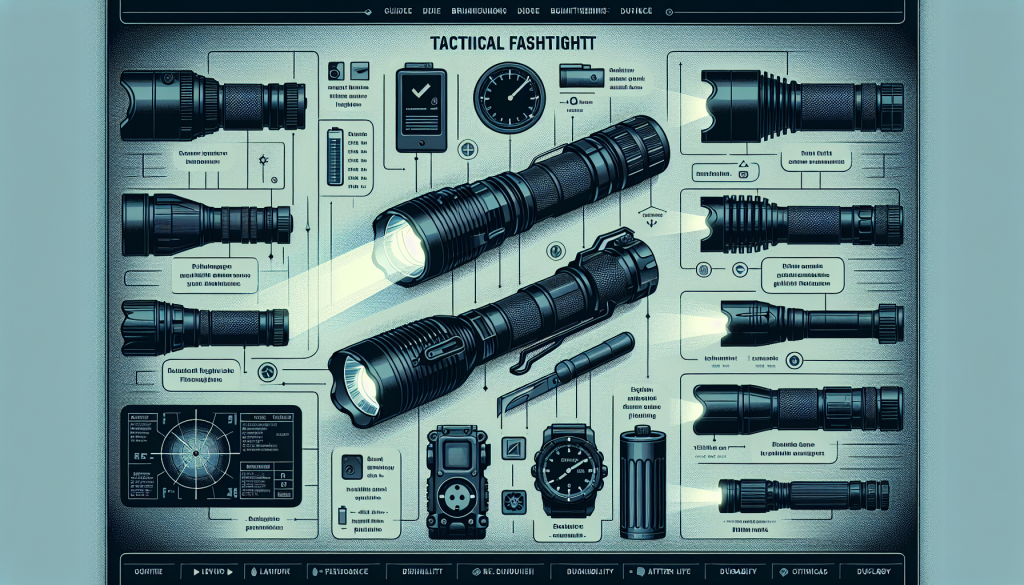
Battery Options and Considerations
Different types of batteries used in tactical flashlights
Tactical flashlights utilize various types of batteries, each with its own advantages and disadvantages. Commonly used battery options include alkaline batteries, lithium-ion batteries, and rechargeable batteries.
- Alkaline batteries: Alkaline batteries are readily available, affordable, and often come included with flashlights. However, they have a limited lifespan and may require frequent replacement.
- Lithium-ion batteries: Lithium-ion batteries offer a longer lifespan compared to alkaline batteries and provide a more consistent power output. These batteries are rechargeable and can be an economical choice in the long run.
- Rechargeable batteries: Some tactical flashlights come with rechargeable batteries, usually lithium-ion or nickel-metal hydride (NiMH). Rechargeable batteries eliminate the need for constantly purchasing disposable batteries and can be recharged using a wall adapter, USB cable, or portable power bank.
Pros and cons of each battery type
When considering the pros and cons of each battery type, there are a few key factors to keep in mind. Alkaline batteries are widely available and can be purchased almost anywhere, making them convenient for emergencies or situations where immediate replacements are needed. However, they tend to have a shorter lifespan and can become costly if you frequently use your flashlight. Lithium-ion batteries offer longer battery life and more consistent power output, making them a reliable choice. Rechargeable batteries are environmentally friendly and cost-effective in the long run but require access to charging options.
Rechargeable vs. disposable batteries
The decision between rechargeable and disposable batteries ultimately depends on your usage patterns and personal preferences. Rechargeable batteries are an excellent choice if you consistently use your flashlight and have access to charging methods. They offer convenience, cost savings, and are more environmentally friendly. On the other hand, disposable batteries can be convenient if you’re in a situation where recharging is not possible or if you need a quick and easy battery replacement.
Battery life indicators and features
To gauge the remaining battery life of your tactical flashlight, some models feature battery life indicators. These indicators can be visual, such as LED lights that display the battery level, or functional, where the flashlight automatically adjusts the brightness level as the battery drains. Battery life indicators and features can help you plan and manage your flashlight’s usage, ensuring that you never find yourself without light when you need it the most.
Finding the Ideal Size and Weight
Distinguish preferred size based on application
The ideal size of a tactical flashlight is determined by the specific application and your personal preferences. A compact and lightweight flashlight is suitable for everyday carry, allowing you to easily slip it into your pocket or bag. These flashlights are often more comfortable to hold for extended periods and won’t weigh you down during day-to-day activities. However, if you need a flashlight for outdoor adventures or tasks that require a more robust lighting solution, a larger flashlight with added features and a solid grip may be more suitable.
Balancing weight and functionality
When choosing a tactical flashlight, it’s essential to find a balance between weight and functionality. A lightweight flashlight is generally more comfortable to carry and can easily be stored in your pocket or backpack. However, it’s important to ensure that the weight reduction doesn’t compromise essential features and durability. While a heavier flashlight may be beneficial for certain tasks, it’s essential to consider if the added weight is worth the trade-off in terms of convenience.
Ease of carrying and storage
The ease of carrying and storage is an important consideration when selecting a tactical flashlight. Look for flashlights that come with features such as belt clips, lanyard holes, or pocket clips, as these can make carrying your flashlight more convenient. Flashlights with compact designs are easier to store and transport, allowing you to keep them readily accessible in a variety of situations. Consider your specific needs and how you plan to carry or store the flashlight to ensure maximum convenience and accessibility.
Understanding Durability and Construction
Materials used for construction
Tactical flashlights are constructed with durability in mind, and the choice of materials plays a significant role in their robustness. Common materials used for the construction of tactical flashlights include aluminum, stainless steel, and rugged polymers. Aluminum is lightweight, durable, and resistant to corrosion, making it a popular choice for flashlight bodies. Stainless steel adds an extra level of strength and durability, making flashlights more impact-resistant. Rugged polymers are lightweight and provide excellent impact resistance, making flashlights more suitable for outdoor use.
Impact resistance and drop tests
To ensure durability, many tactical flashlights undergo drop tests to assess their impact resistance. These tests involve dropping the flashlight onto a hard surface from a specified height, simulating real-life scenarios where the flashlight may accidentally fall or be subject to rough handling. Flashlights that pass drop tests are more likely to withstand accidental drops, impacts, and harsh conditions without compromising their functionality.
Protection against dust and debris
Tactical flashlights often come with features that protect them from dust and debris. This is especially important if you plan to use the flashlight in dusty environments, such as construction sites or outdoor adventures. Look for flashlights with O-ring seals or gaskets that prevent dust, dirt, and debris from entering the flashlight’s internals. These features help maintain the flashlight’s performance and longevity by preventing damage caused by particles or contaminants.
Shock resistance and waterproofing
In addition to impact resistance, many tactical flashlights are designed to be shock-resistant. This means they can handle accidental drops or impacts without sustaining significant damage. Shock resistance is particularly important if you plan to use the flashlight in rugged environments or if you engage in activities that involve rough handling. Furthermore, waterproofing is another crucial aspect of flashlight durability. A waterproof flashlight can withstand exposure to rain, splashes, and even being submerged in water for a certain period. Look for flashlights with appropriate waterproof ratings to ensure they can handle wet conditions without malfunctioning.
Waterproofing and Weather Resistance
Degrees of water resistance
When it comes to waterproofing and weather resistance, flashlights are often rated based on their level of protection. The IPX rating system is commonly used to indicate a flashlight’s water resistance capabilities. The ratings range from IPX0 (no protection against water) to IPX8 (submersible to a specified depth). Depending on your needs and the anticipated environments where you will be using the flashlight, choose a waterproof rating that provides adequate protection against rain, splashes, and submersion.
Testing standards for waterproofing
To determine a flashlight’s waterproof capabilities, it undergoes rigorous testing to meet specific standards. These testing standards vary depending on the certification and manufacturer, but common tests include submersion tests, water spray tests, and high-pressure water jet tests. These tests simulate real-world conditions and ensure that the flashlight can withstand water exposure without compromising its functionality or safety.
IPX ratings and their meaning
IPX ratings are used to classify the degree of water resistance of a flashlight. The “IP” in IPX stands for “Ingress Protection,” and the “X” signifies that the rating applies only to water resistance and does not apply to solid particle protection. The numeric rating (e.g., IPX7) indicates the level of water resistance. For example, an IPX7-rated flashlight can be submerged in water up to 1 meter deep for 30 minutes without suffering damage. Choosing a flashlight with an appropriate IPX rating ensures that it can handle the water exposure you anticipate in your specific use cases.
Exploring Additional Features and Accessories
Strobe and SOS modes
Many tactical flashlights feature additional modes such as strobe and SOS (distress signal) modes. Strobe mode emits a fast flashing light that can disorient an attacker or attract attention in emergency situations. SOS mode emits a specific light pattern recognized as a universal distress signal, making it useful in survival or emergency situations. These additional modes can provide added functionality and versatility to your tactical flashlight, allowing you to adapt to different scenarios.
Zoom and adjustable focus
Some tactical flashlights offer zoom and adjustable focus features, allowing you to adjust the beam of light to suit your needs. These flashlights enable you to switch between a wide floodlight beam for illuminating a broad area or a focused spotlight beam for long-distance visibility. The zoom and adjustable focus capabilities allow you to customize the flashlight’s light output based on the specific task or environment.
Multiple brightness levels and memory modes
Flashlights with multiple brightness levels give you more control over the output of light, allowing you to adjust the brightness according to your needs. This feature can extend the runtime of your flashlight and provide flexibility in different situations. Additionally, memory modes remember the last brightness level used, making it easy to resume your preferred setting without cycling through all the available options each time you turn on your flashlight.
Clip and holster options
Many tactical flashlights come with clip or holster options for easy and secure storage. A clip allows you to attach the flashlight to your belt, pocket, or backpack for quick access and hands-free carrying. A holster provides even more protection and security, preventing the flashlight from accidentally falling out or getting damaged in rugged environments. Convenient storage options enhance the portability and accessibility of your flashlight.
Finding the Best Tactical Flashlight
Researching reputable brands and customer reviews
To find the best tactical flashlight for your needs, it’s essential to research reputable brands and read customer reviews. Reputable brands often have a history of producing high-quality flashlights and providing excellent customer service. Reading customer reviews can give you insight into the reliability, durability, and performance of specific flashlight models. Consider the feedback and experiences of others to make an informed decision about which brand and model will best suit your requirements.
Considering specific needs and use cases
Before purchasing a tactical flashlight, carefully consider your specific needs and use cases. Ask yourself questions such as: What activities will I be using the flashlight for? Do I need a compact flashlight for everyday carry or a larger flashlight for outdoor adventures? How important are additional features like strobe mode or adjustable focus? By understanding your requirements, you can narrow down your options and choose a flashlight that meets your specific needs.
Comparing specifications and features
When comparing different tactical flashlights, take note of their specifications and features. Compare factors such as brightness levels, battery life, construction materials, and water resistance capabilities. Pay attention to the specific features that are important to you, such as adjustable focus or multiple brightness levels. By comparing the specifications and features of different flashlights, you can determine which ones meet your criteria and are most suitable for your intended use.
Making an informed decision
Ultimately, choosing the best tactical flashlight comes down to making an informed decision based on your research, needs, and preferences. Take the time to evaluate the options available to you, considering factors such as durability, battery life, brightness level, size, weight, and additional features. By weighing these factors against your specific requirements, you can find a tactical flashlight that provides the functionality, reliability, and performance you need in various situations.

